Accounting Theory Solved Assignment
VerifiedAdded on 2021/02/20
|11
|3118
|79
AI Summary
Contribute Materials
Your contribution can guide someone’s learning journey. Share your
documents today.
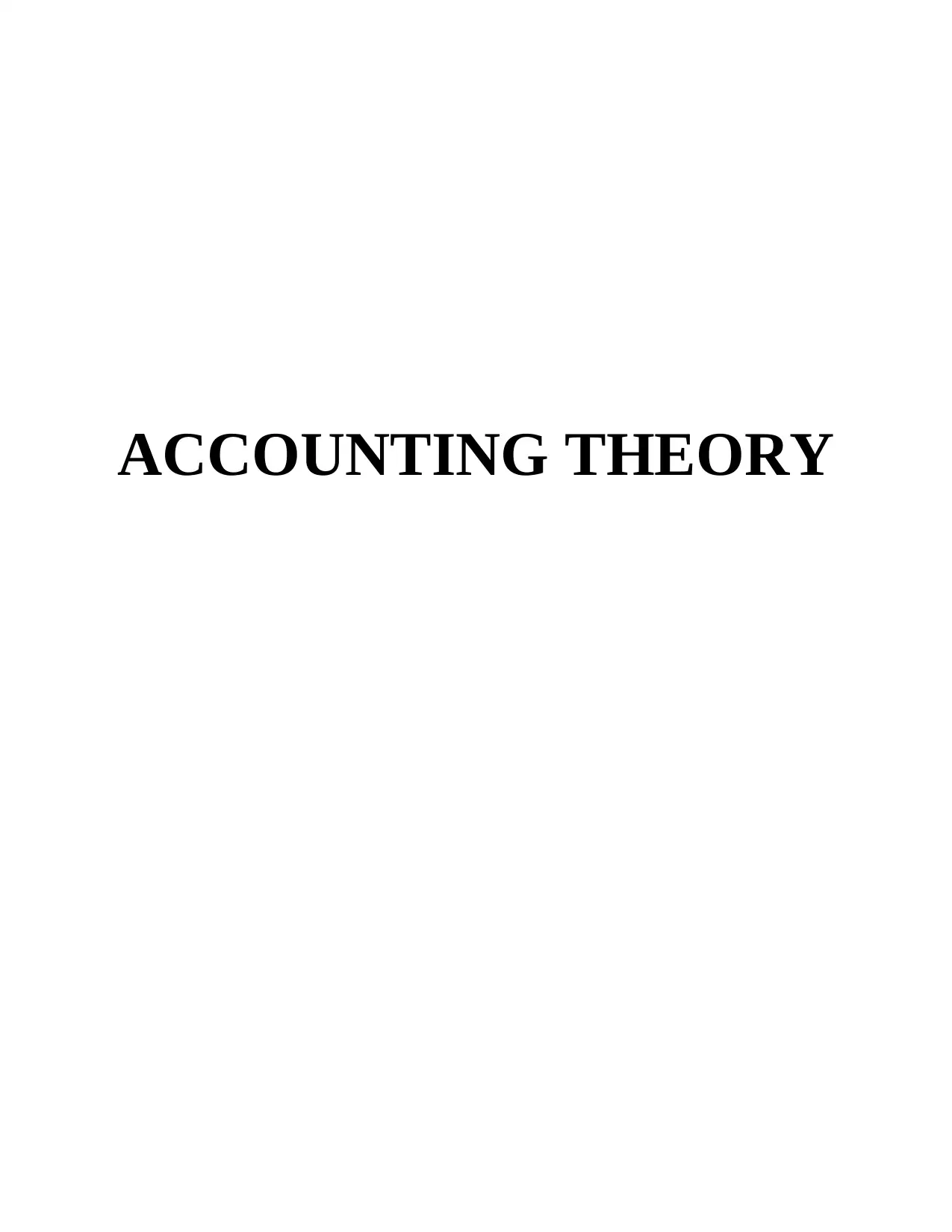
ACCOUNTING THEORY
Secure Best Marks with AI Grader
Need help grading? Try our AI Grader for instant feedback on your assignments.
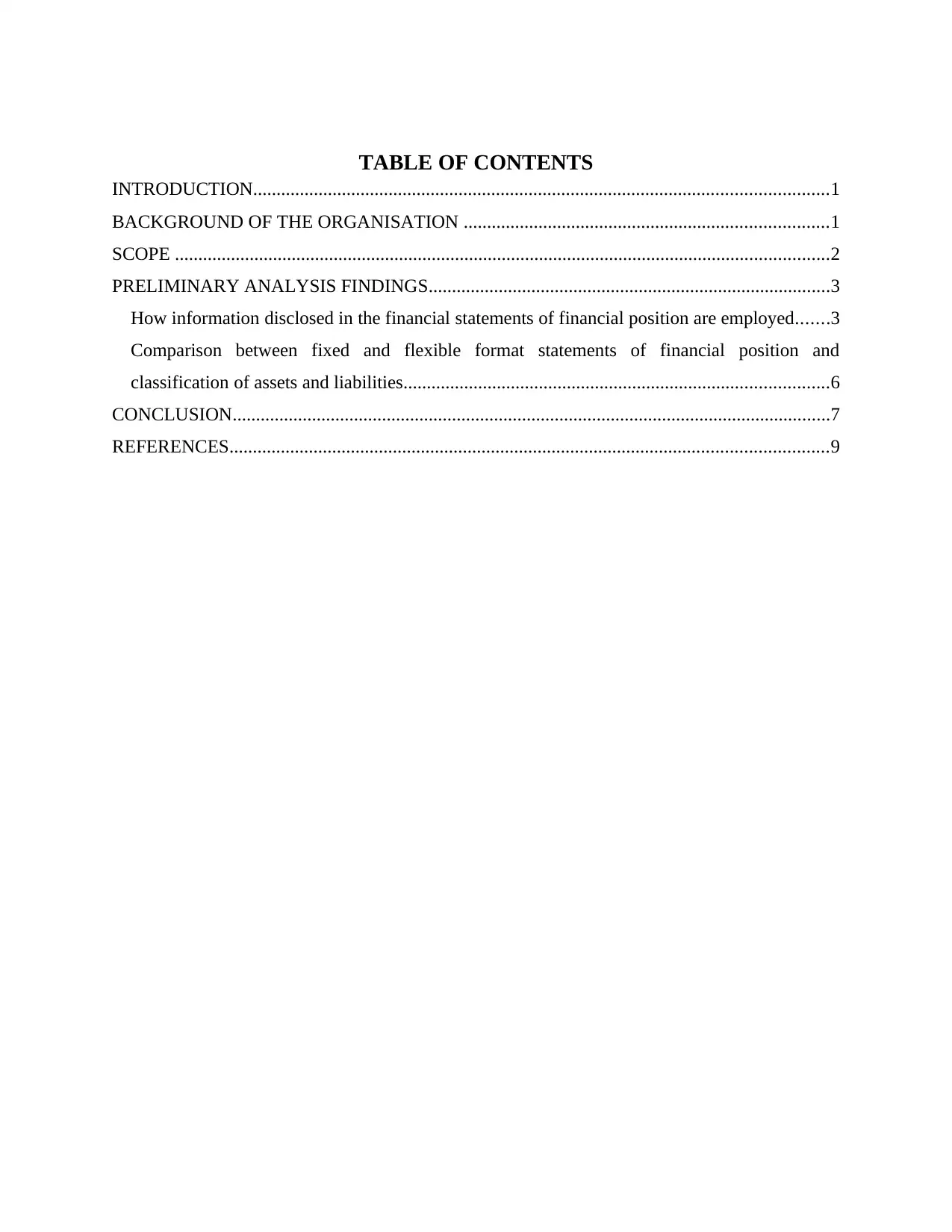
TABLE OF CONTENTS
INTRODUCTION...........................................................................................................................1
BACKGROUND OF THE ORGANISATION ..............................................................................1
SCOPE ............................................................................................................................................2
PRELIMINARY ANALYSIS FINDINGS......................................................................................3
How information disclosed in the financial statements of financial position are employed.......3
Comparison between fixed and flexible format statements of financial position and
classification of assets and liabilities...........................................................................................6
CONCLUSION................................................................................................................................7
REFERENCES................................................................................................................................9
INTRODUCTION...........................................................................................................................1
BACKGROUND OF THE ORGANISATION ..............................................................................1
SCOPE ............................................................................................................................................2
PRELIMINARY ANALYSIS FINDINGS......................................................................................3
How information disclosed in the financial statements of financial position are employed.......3
Comparison between fixed and flexible format statements of financial position and
classification of assets and liabilities...........................................................................................6
CONCLUSION................................................................................................................................7
REFERENCES................................................................................................................................9
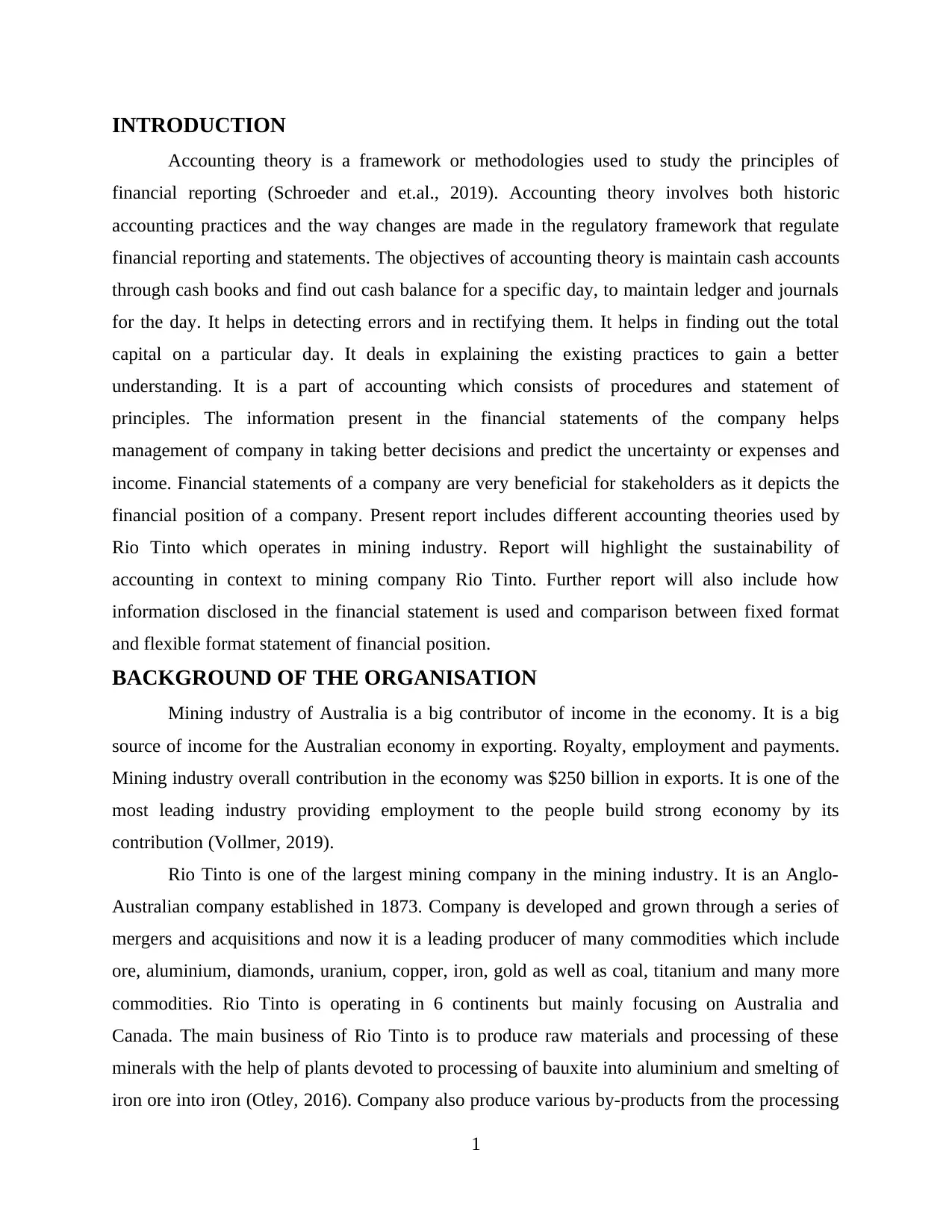
INTRODUCTION
Accounting theory is a framework or methodologies used to study the principles of
financial reporting (Schroeder and et.al., 2019). Accounting theory involves both historic
accounting practices and the way changes are made in the regulatory framework that regulate
financial reporting and statements. The objectives of accounting theory is maintain cash accounts
through cash books and find out cash balance for a specific day, to maintain ledger and journals
for the day. It helps in detecting errors and in rectifying them. It helps in finding out the total
capital on a particular day. It deals in explaining the existing practices to gain a better
understanding. It is a part of accounting which consists of procedures and statement of
principles. The information present in the financial statements of the company helps
management of company in taking better decisions and predict the uncertainty or expenses and
income. Financial statements of a company are very beneficial for stakeholders as it depicts the
financial position of a company. Present report includes different accounting theories used by
Rio Tinto which operates in mining industry. Report will highlight the sustainability of
accounting in context to mining company Rio Tinto. Further report will also include how
information disclosed in the financial statement is used and comparison between fixed format
and flexible format statement of financial position.
BACKGROUND OF THE ORGANISATION
Mining industry of Australia is a big contributor of income in the economy. It is a big
source of income for the Australian economy in exporting. Royalty, employment and payments.
Mining industry overall contribution in the economy was $250 billion in exports. It is one of the
most leading industry providing employment to the people build strong economy by its
contribution (Vollmer, 2019).
Rio Tinto is one of the largest mining company in the mining industry. It is an Anglo-
Australian company established in 1873. Company is developed and grown through a series of
mergers and acquisitions and now it is a leading producer of many commodities which include
ore, aluminium, diamonds, uranium, copper, iron, gold as well as coal, titanium and many more
commodities. Rio Tinto is operating in 6 continents but mainly focusing on Australia and
Canada. The main business of Rio Tinto is to produce raw materials and processing of these
minerals with the help of plants devoted to processing of bauxite into aluminium and smelting of
iron ore into iron (Otley, 2016). Company also produce various by-products from the processing
1
Accounting theory is a framework or methodologies used to study the principles of
financial reporting (Schroeder and et.al., 2019). Accounting theory involves both historic
accounting practices and the way changes are made in the regulatory framework that regulate
financial reporting and statements. The objectives of accounting theory is maintain cash accounts
through cash books and find out cash balance for a specific day, to maintain ledger and journals
for the day. It helps in detecting errors and in rectifying them. It helps in finding out the total
capital on a particular day. It deals in explaining the existing practices to gain a better
understanding. It is a part of accounting which consists of procedures and statement of
principles. The information present in the financial statements of the company helps
management of company in taking better decisions and predict the uncertainty or expenses and
income. Financial statements of a company are very beneficial for stakeholders as it depicts the
financial position of a company. Present report includes different accounting theories used by
Rio Tinto which operates in mining industry. Report will highlight the sustainability of
accounting in context to mining company Rio Tinto. Further report will also include how
information disclosed in the financial statement is used and comparison between fixed format
and flexible format statement of financial position.
BACKGROUND OF THE ORGANISATION
Mining industry of Australia is a big contributor of income in the economy. It is a big
source of income for the Australian economy in exporting. Royalty, employment and payments.
Mining industry overall contribution in the economy was $250 billion in exports. It is one of the
most leading industry providing employment to the people build strong economy by its
contribution (Vollmer, 2019).
Rio Tinto is one of the largest mining company in the mining industry. It is an Anglo-
Australian company established in 1873. Company is developed and grown through a series of
mergers and acquisitions and now it is a leading producer of many commodities which include
ore, aluminium, diamonds, uranium, copper, iron, gold as well as coal, titanium and many more
commodities. Rio Tinto is operating in 6 continents but mainly focusing on Australia and
Canada. The main business of Rio Tinto is to produce raw materials and processing of these
minerals with the help of plants devoted to processing of bauxite into aluminium and smelting of
iron ore into iron (Otley, 2016). Company also produce various by-products from the processing
1
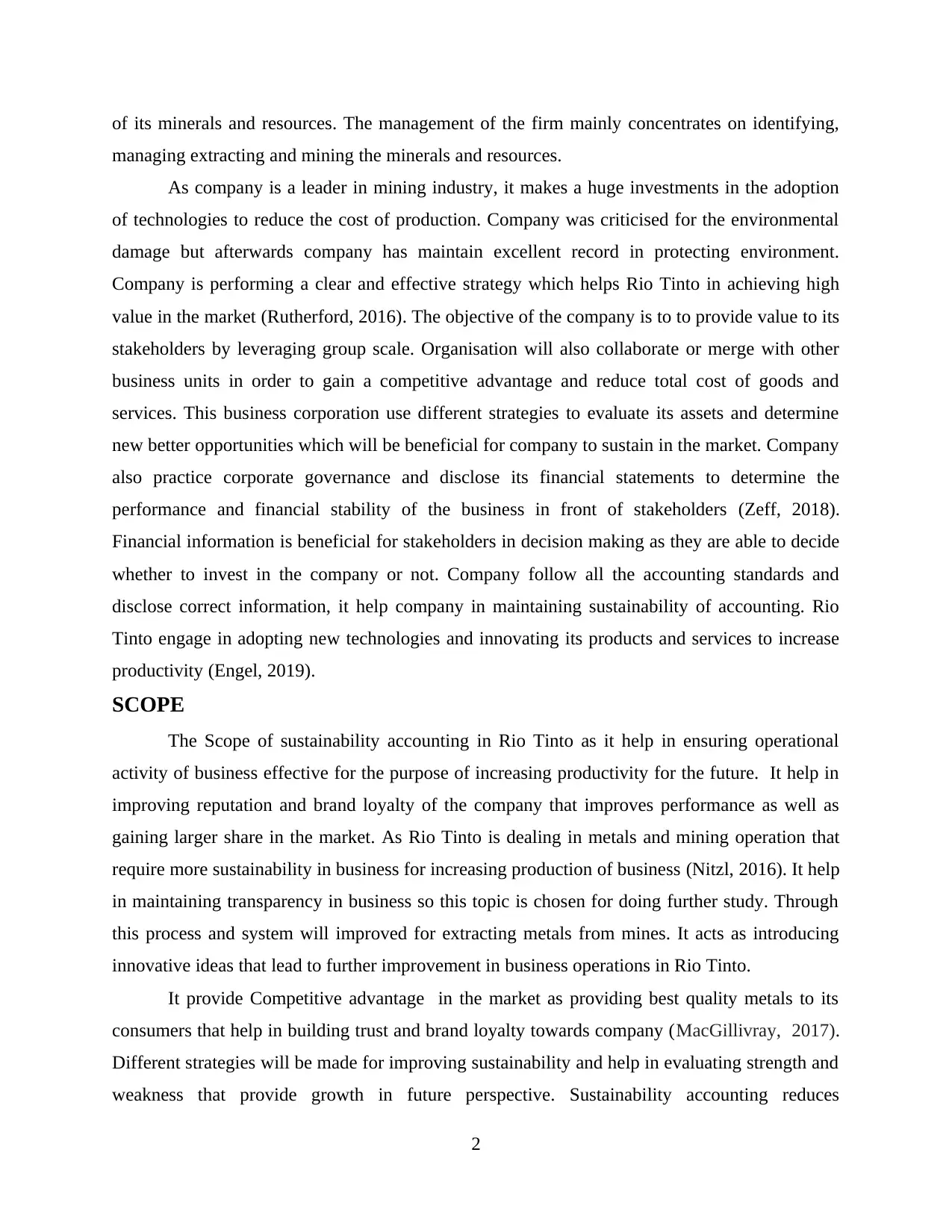
of its minerals and resources. The management of the firm mainly concentrates on identifying,
managing extracting and mining the minerals and resources.
As company is a leader in mining industry, it makes a huge investments in the adoption
of technologies to reduce the cost of production. Company was criticised for the environmental
damage but afterwards company has maintain excellent record in protecting environment.
Company is performing a clear and effective strategy which helps Rio Tinto in achieving high
value in the market (Rutherford, 2016). The objective of the company is to to provide value to its
stakeholders by leveraging group scale. Organisation will also collaborate or merge with other
business units in order to gain a competitive advantage and reduce total cost of goods and
services. This business corporation use different strategies to evaluate its assets and determine
new better opportunities which will be beneficial for company to sustain in the market. Company
also practice corporate governance and disclose its financial statements to determine the
performance and financial stability of the business in front of stakeholders (Zeff, 2018).
Financial information is beneficial for stakeholders in decision making as they are able to decide
whether to invest in the company or not. Company follow all the accounting standards and
disclose correct information, it help company in maintaining sustainability of accounting. Rio
Tinto engage in adopting new technologies and innovating its products and services to increase
productivity (Engel, 2019).
SCOPE
The Scope of sustainability accounting in Rio Tinto as it help in ensuring operational
activity of business effective for the purpose of increasing productivity for the future. It help in
improving reputation and brand loyalty of the company that improves performance as well as
gaining larger share in the market. As Rio Tinto is dealing in metals and mining operation that
require more sustainability in business for increasing production of business (Nitzl, 2016). It help
in maintaining transparency in business so this topic is chosen for doing further study. Through
this process and system will improved for extracting metals from mines. It acts as introducing
innovative ideas that lead to further improvement in business operations in Rio Tinto.
It provide Competitive advantage in the market as providing best quality metals to its
consumers that help in building trust and brand loyalty towards company (MacGillivray, 2017).
Different strategies will be made for improving sustainability and help in evaluating strength and
weakness that provide growth in future perspective. Sustainability accounting reduces
2
managing extracting and mining the minerals and resources.
As company is a leader in mining industry, it makes a huge investments in the adoption
of technologies to reduce the cost of production. Company was criticised for the environmental
damage but afterwards company has maintain excellent record in protecting environment.
Company is performing a clear and effective strategy which helps Rio Tinto in achieving high
value in the market (Rutherford, 2016). The objective of the company is to to provide value to its
stakeholders by leveraging group scale. Organisation will also collaborate or merge with other
business units in order to gain a competitive advantage and reduce total cost of goods and
services. This business corporation use different strategies to evaluate its assets and determine
new better opportunities which will be beneficial for company to sustain in the market. Company
also practice corporate governance and disclose its financial statements to determine the
performance and financial stability of the business in front of stakeholders (Zeff, 2018).
Financial information is beneficial for stakeholders in decision making as they are able to decide
whether to invest in the company or not. Company follow all the accounting standards and
disclose correct information, it help company in maintaining sustainability of accounting. Rio
Tinto engage in adopting new technologies and innovating its products and services to increase
productivity (Engel, 2019).
SCOPE
The Scope of sustainability accounting in Rio Tinto as it help in ensuring operational
activity of business effective for the purpose of increasing productivity for the future. It help in
improving reputation and brand loyalty of the company that improves performance as well as
gaining larger share in the market. As Rio Tinto is dealing in metals and mining operation that
require more sustainability in business for increasing production of business (Nitzl, 2016). It help
in maintaining transparency in business so this topic is chosen for doing further study. Through
this process and system will improved for extracting metals from mines. It acts as introducing
innovative ideas that lead to further improvement in business operations in Rio Tinto.
It provide Competitive advantage in the market as providing best quality metals to its
consumers that help in building trust and brand loyalty towards company (MacGillivray, 2017).
Different strategies will be made for improving sustainability and help in evaluating strength and
weakness that provide growth in future perspective. Sustainability accounting reduces
2
Secure Best Marks with AI Grader
Need help grading? Try our AI Grader for instant feedback on your assignments.
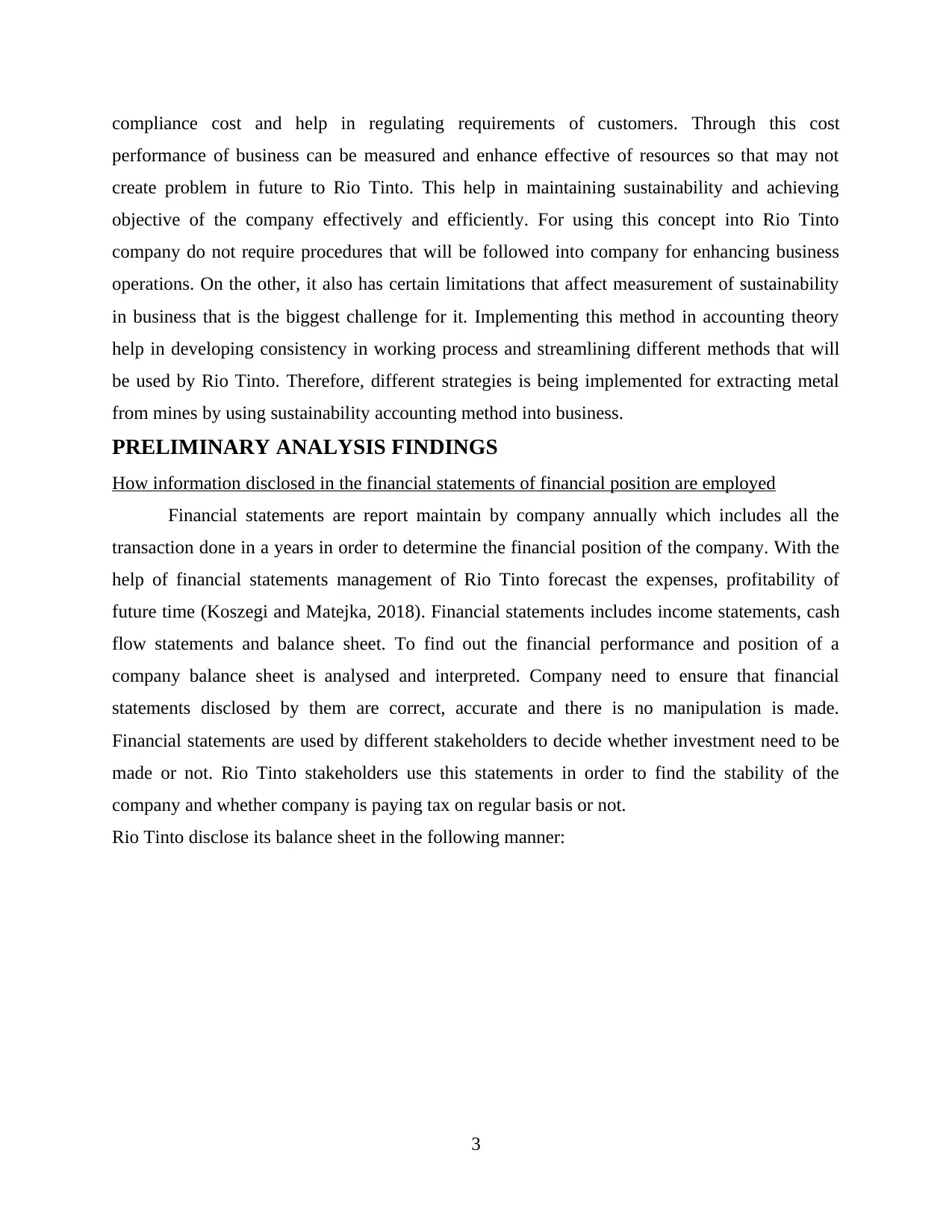
compliance cost and help in regulating requirements of customers. Through this cost
performance of business can be measured and enhance effective of resources so that may not
create problem in future to Rio Tinto. This help in maintaining sustainability and achieving
objective of the company effectively and efficiently. For using this concept into Rio Tinto
company do not require procedures that will be followed into company for enhancing business
operations. On the other, it also has certain limitations that affect measurement of sustainability
in business that is the biggest challenge for it. Implementing this method in accounting theory
help in developing consistency in working process and streamlining different methods that will
be used by Rio Tinto. Therefore, different strategies is being implemented for extracting metal
from mines by using sustainability accounting method into business.
PRELIMINARY ANALYSIS FINDINGS
How information disclosed in the financial statements of financial position are employed
Financial statements are report maintain by company annually which includes all the
transaction done in a years in order to determine the financial position of the company. With the
help of financial statements management of Rio Tinto forecast the expenses, profitability of
future time (Koszegi and Matejka, 2018). Financial statements includes income statements, cash
flow statements and balance sheet. To find out the financial performance and position of a
company balance sheet is analysed and interpreted. Company need to ensure that financial
statements disclosed by them are correct, accurate and there is no manipulation is made.
Financial statements are used by different stakeholders to decide whether investment need to be
made or not. Rio Tinto stakeholders use this statements in order to find the stability of the
company and whether company is paying tax on regular basis or not.
Rio Tinto disclose its balance sheet in the following manner:
3
performance of business can be measured and enhance effective of resources so that may not
create problem in future to Rio Tinto. This help in maintaining sustainability and achieving
objective of the company effectively and efficiently. For using this concept into Rio Tinto
company do not require procedures that will be followed into company for enhancing business
operations. On the other, it also has certain limitations that affect measurement of sustainability
in business that is the biggest challenge for it. Implementing this method in accounting theory
help in developing consistency in working process and streamlining different methods that will
be used by Rio Tinto. Therefore, different strategies is being implemented for extracting metal
from mines by using sustainability accounting method into business.
PRELIMINARY ANALYSIS FINDINGS
How information disclosed in the financial statements of financial position are employed
Financial statements are report maintain by company annually which includes all the
transaction done in a years in order to determine the financial position of the company. With the
help of financial statements management of Rio Tinto forecast the expenses, profitability of
future time (Koszegi and Matejka, 2018). Financial statements includes income statements, cash
flow statements and balance sheet. To find out the financial performance and position of a
company balance sheet is analysed and interpreted. Company need to ensure that financial
statements disclosed by them are correct, accurate and there is no manipulation is made.
Financial statements are used by different stakeholders to decide whether investment need to be
made or not. Rio Tinto stakeholders use this statements in order to find the stability of the
company and whether company is paying tax on regular basis or not.
Rio Tinto disclose its balance sheet in the following manner:
3
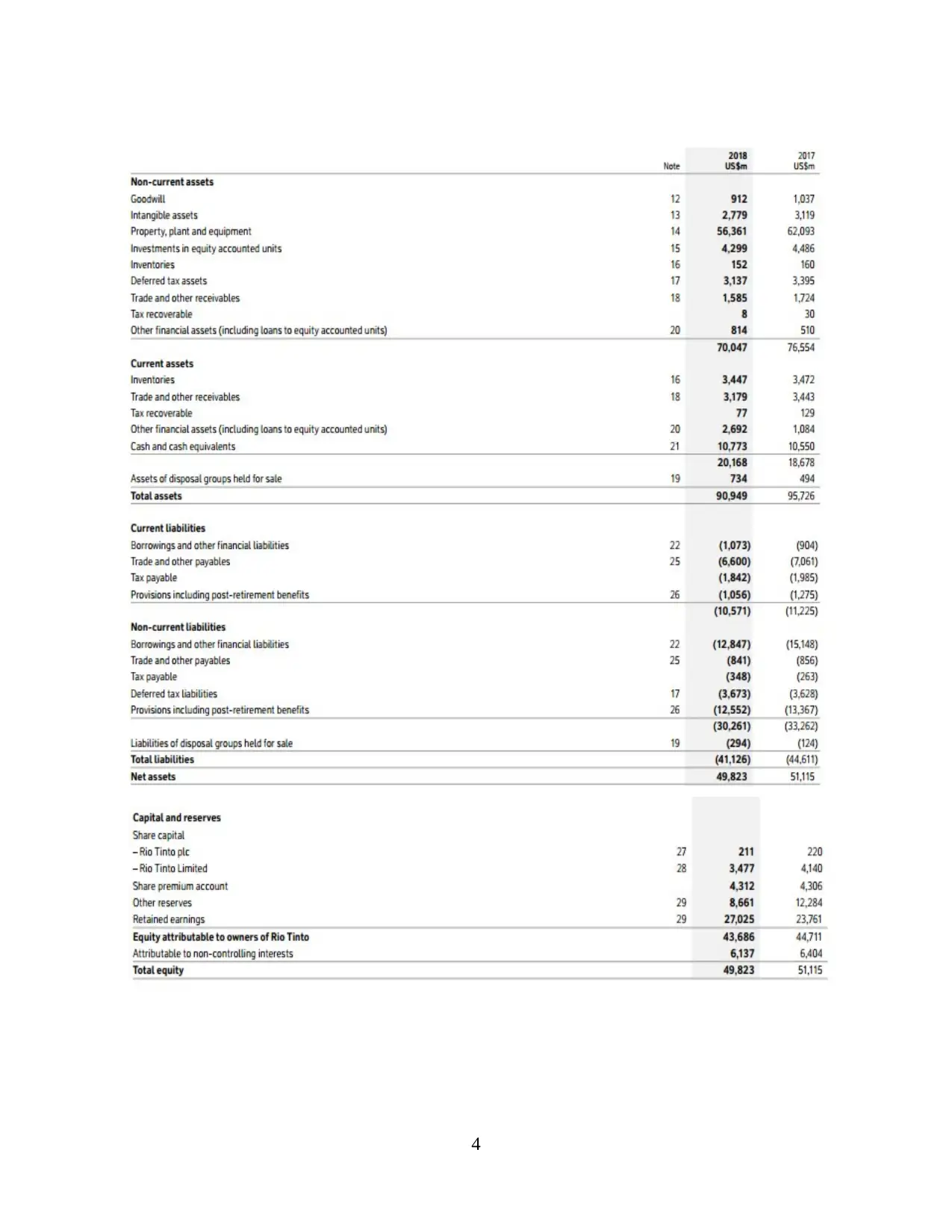
4
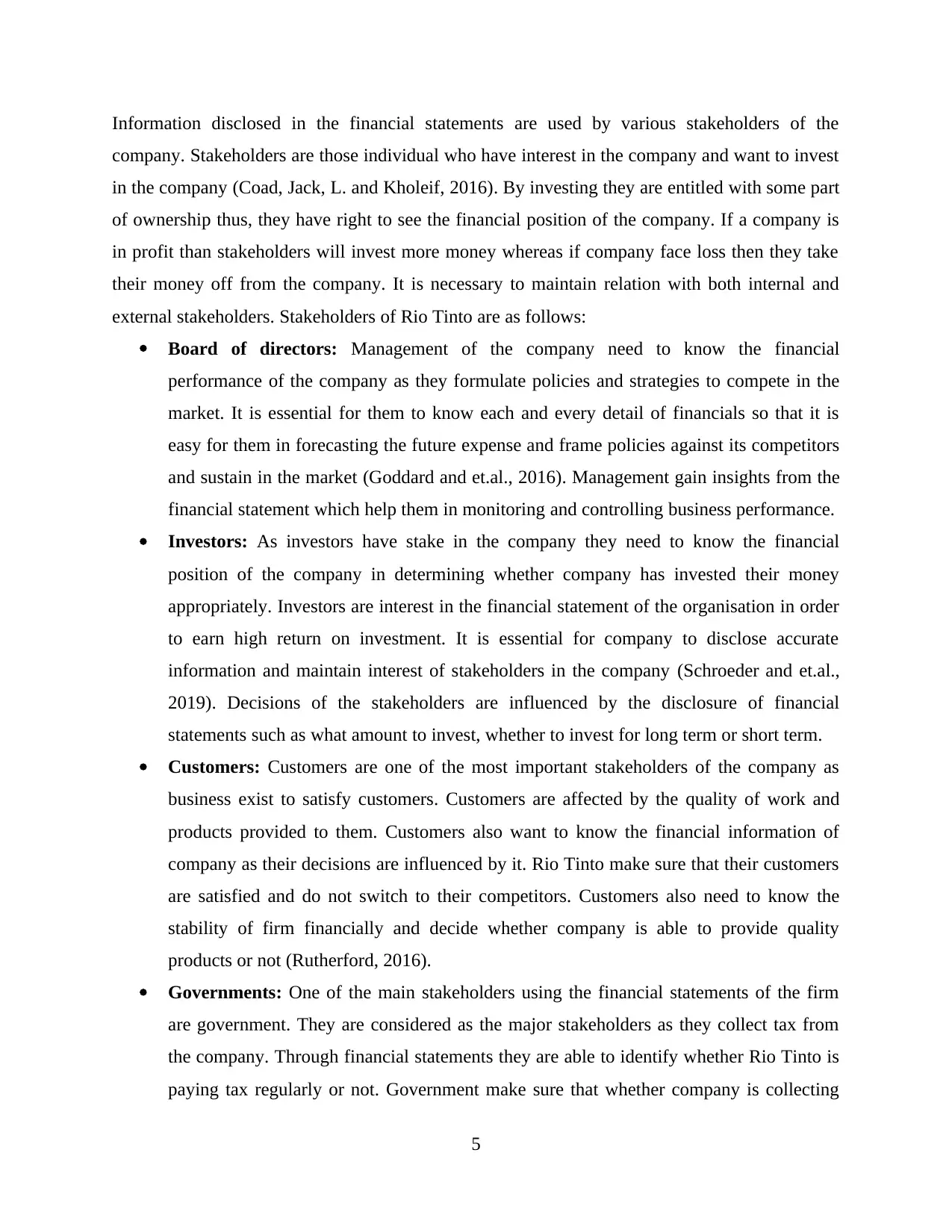
Information disclosed in the financial statements are used by various stakeholders of the
company. Stakeholders are those individual who have interest in the company and want to invest
in the company (Coad, Jack, L. and Kholeif, 2016). By investing they are entitled with some part
of ownership thus, they have right to see the financial position of the company. If a company is
in profit than stakeholders will invest more money whereas if company face loss then they take
their money off from the company. It is necessary to maintain relation with both internal and
external stakeholders. Stakeholders of Rio Tinto are as follows:
Board of directors: Management of the company need to know the financial
performance of the company as they formulate policies and strategies to compete in the
market. It is essential for them to know each and every detail of financials so that it is
easy for them in forecasting the future expense and frame policies against its competitors
and sustain in the market (Goddard and et.al., 2016). Management gain insights from the
financial statement which help them in monitoring and controlling business performance.
Investors: As investors have stake in the company they need to know the financial
position of the company in determining whether company has invested their money
appropriately. Investors are interest in the financial statement of the organisation in order
to earn high return on investment. It is essential for company to disclose accurate
information and maintain interest of stakeholders in the company (Schroeder and et.al.,
2019). Decisions of the stakeholders are influenced by the disclosure of financial
statements such as what amount to invest, whether to invest for long term or short term.
Customers: Customers are one of the most important stakeholders of the company as
business exist to satisfy customers. Customers are affected by the quality of work and
products provided to them. Customers also want to know the financial information of
company as their decisions are influenced by it. Rio Tinto make sure that their customers
are satisfied and do not switch to their competitors. Customers also need to know the
stability of firm financially and decide whether company is able to provide quality
products or not (Rutherford, 2016).
Governments: One of the main stakeholders using the financial statements of the firm
are government. They are considered as the major stakeholders as they collect tax from
the company. Through financial statements they are able to identify whether Rio Tinto is
paying tax regularly or not. Government make sure that whether company is collecting
5
company. Stakeholders are those individual who have interest in the company and want to invest
in the company (Coad, Jack, L. and Kholeif, 2016). By investing they are entitled with some part
of ownership thus, they have right to see the financial position of the company. If a company is
in profit than stakeholders will invest more money whereas if company face loss then they take
their money off from the company. It is necessary to maintain relation with both internal and
external stakeholders. Stakeholders of Rio Tinto are as follows:
Board of directors: Management of the company need to know the financial
performance of the company as they formulate policies and strategies to compete in the
market. It is essential for them to know each and every detail of financials so that it is
easy for them in forecasting the future expense and frame policies against its competitors
and sustain in the market (Goddard and et.al., 2016). Management gain insights from the
financial statement which help them in monitoring and controlling business performance.
Investors: As investors have stake in the company they need to know the financial
position of the company in determining whether company has invested their money
appropriately. Investors are interest in the financial statement of the organisation in order
to earn high return on investment. It is essential for company to disclose accurate
information and maintain interest of stakeholders in the company (Schroeder and et.al.,
2019). Decisions of the stakeholders are influenced by the disclosure of financial
statements such as what amount to invest, whether to invest for long term or short term.
Customers: Customers are one of the most important stakeholders of the company as
business exist to satisfy customers. Customers are affected by the quality of work and
products provided to them. Customers also want to know the financial information of
company as their decisions are influenced by it. Rio Tinto make sure that their customers
are satisfied and do not switch to their competitors. Customers also need to know the
stability of firm financially and decide whether company is able to provide quality
products or not (Rutherford, 2016).
Governments: One of the main stakeholders using the financial statements of the firm
are government. They are considered as the major stakeholders as they collect tax from
the company. Through financial statements they are able to identify whether Rio Tinto is
paying tax regularly or not. Government make sure that whether company is collecting
5
Paraphrase This Document
Need a fresh take? Get an instant paraphrase of this document with our AI Paraphraser
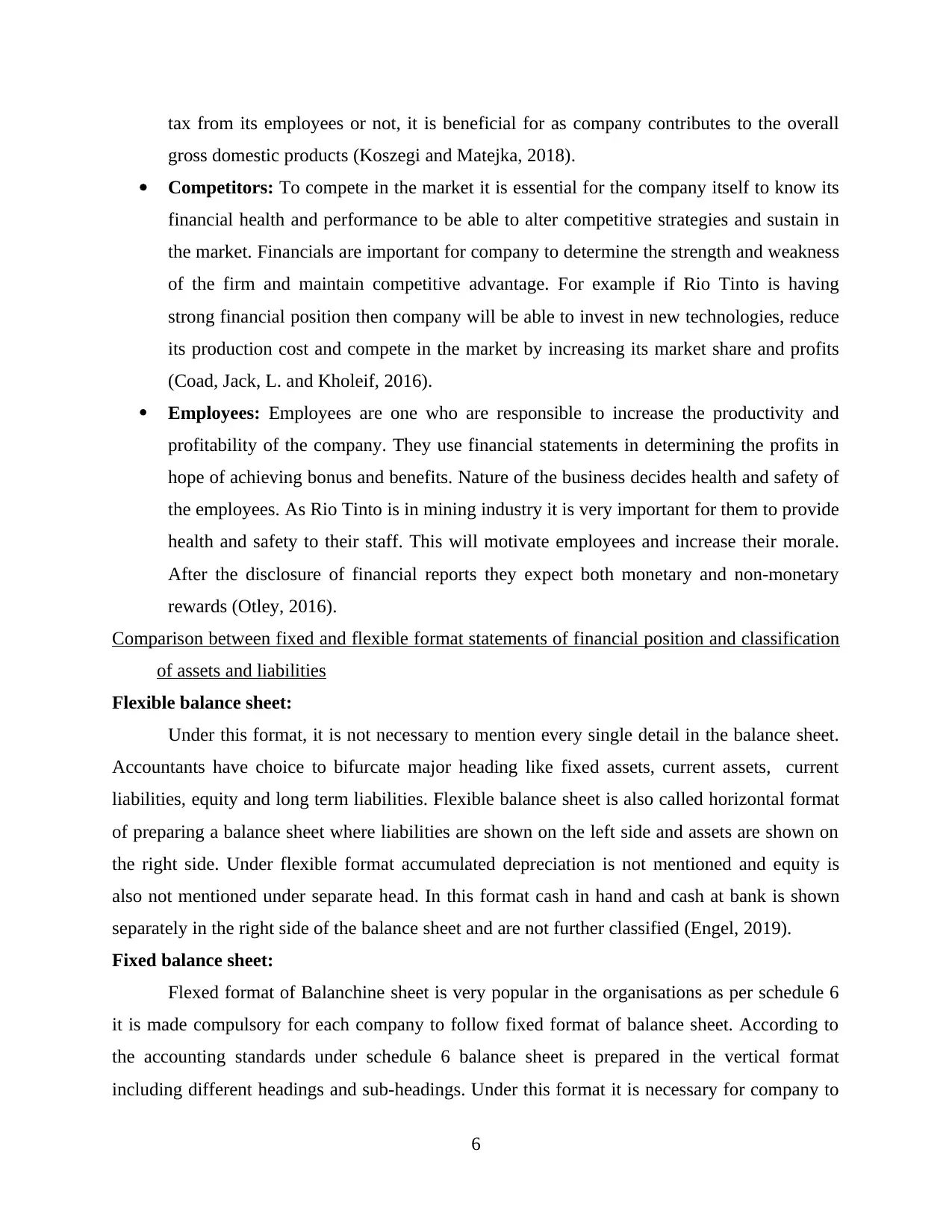
tax from its employees or not, it is beneficial for as company contributes to the overall
gross domestic products (Koszegi and Matejka, 2018).
Competitors: To compete in the market it is essential for the company itself to know its
financial health and performance to be able to alter competitive strategies and sustain in
the market. Financials are important for company to determine the strength and weakness
of the firm and maintain competitive advantage. For example if Rio Tinto is having
strong financial position then company will be able to invest in new technologies, reduce
its production cost and compete in the market by increasing its market share and profits
(Coad, Jack, L. and Kholeif, 2016).
Employees: Employees are one who are responsible to increase the productivity and
profitability of the company. They use financial statements in determining the profits in
hope of achieving bonus and benefits. Nature of the business decides health and safety of
the employees. As Rio Tinto is in mining industry it is very important for them to provide
health and safety to their staff. This will motivate employees and increase their morale.
After the disclosure of financial reports they expect both monetary and non-monetary
rewards (Otley, 2016).
Comparison between fixed and flexible format statements of financial position and classification
of assets and liabilities
Flexible balance sheet:
Under this format, it is not necessary to mention every single detail in the balance sheet.
Accountants have choice to bifurcate major heading like fixed assets, current assets, current
liabilities, equity and long term liabilities. Flexible balance sheet is also called horizontal format
of preparing a balance sheet where liabilities are shown on the left side and assets are shown on
the right side. Under flexible format accumulated depreciation is not mentioned and equity is
also not mentioned under separate head. In this format cash in hand and cash at bank is shown
separately in the right side of the balance sheet and are not further classified (Engel, 2019).
Fixed balance sheet:
Flexed format of Balanchine sheet is very popular in the organisations as per schedule 6
it is made compulsory for each company to follow fixed format of balance sheet. According to
the accounting standards under schedule 6 balance sheet is prepared in the vertical format
including different headings and sub-headings. Under this format it is necessary for company to
6
gross domestic products (Koszegi and Matejka, 2018).
Competitors: To compete in the market it is essential for the company itself to know its
financial health and performance to be able to alter competitive strategies and sustain in
the market. Financials are important for company to determine the strength and weakness
of the firm and maintain competitive advantage. For example if Rio Tinto is having
strong financial position then company will be able to invest in new technologies, reduce
its production cost and compete in the market by increasing its market share and profits
(Coad, Jack, L. and Kholeif, 2016).
Employees: Employees are one who are responsible to increase the productivity and
profitability of the company. They use financial statements in determining the profits in
hope of achieving bonus and benefits. Nature of the business decides health and safety of
the employees. As Rio Tinto is in mining industry it is very important for them to provide
health and safety to their staff. This will motivate employees and increase their morale.
After the disclosure of financial reports they expect both monetary and non-monetary
rewards (Otley, 2016).
Comparison between fixed and flexible format statements of financial position and classification
of assets and liabilities
Flexible balance sheet:
Under this format, it is not necessary to mention every single detail in the balance sheet.
Accountants have choice to bifurcate major heading like fixed assets, current assets, current
liabilities, equity and long term liabilities. Flexible balance sheet is also called horizontal format
of preparing a balance sheet where liabilities are shown on the left side and assets are shown on
the right side. Under flexible format accumulated depreciation is not mentioned and equity is
also not mentioned under separate head. In this format cash in hand and cash at bank is shown
separately in the right side of the balance sheet and are not further classified (Engel, 2019).
Fixed balance sheet:
Flexed format of Balanchine sheet is very popular in the organisations as per schedule 6
it is made compulsory for each company to follow fixed format of balance sheet. According to
the accounting standards under schedule 6 balance sheet is prepared in the vertical format
including different headings and sub-headings. Under this format it is necessary for company to
6
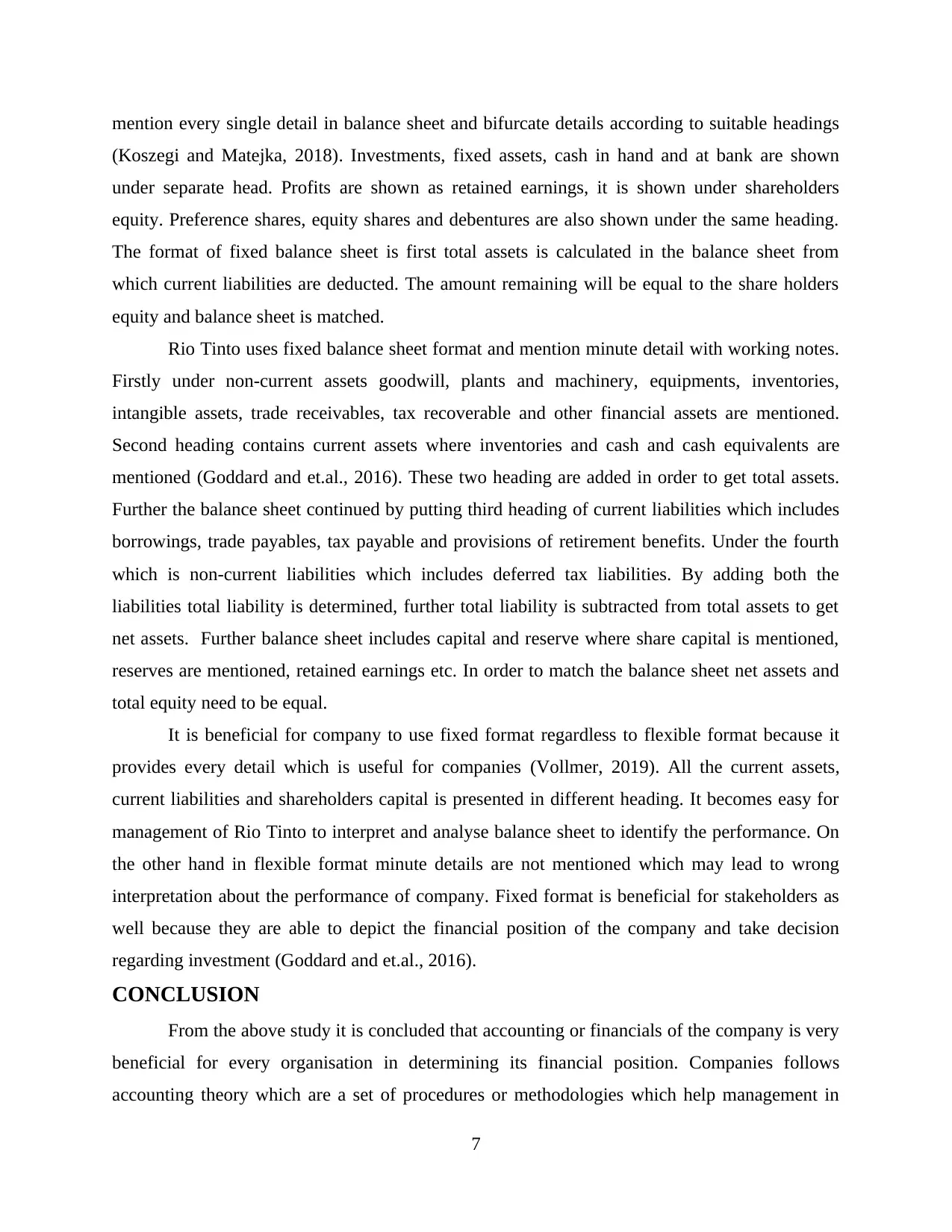
mention every single detail in balance sheet and bifurcate details according to suitable headings
(Koszegi and Matejka, 2018). Investments, fixed assets, cash in hand and at bank are shown
under separate head. Profits are shown as retained earnings, it is shown under shareholders
equity. Preference shares, equity shares and debentures are also shown under the same heading.
The format of fixed balance sheet is first total assets is calculated in the balance sheet from
which current liabilities are deducted. The amount remaining will be equal to the share holders
equity and balance sheet is matched.
Rio Tinto uses fixed balance sheet format and mention minute detail with working notes.
Firstly under non-current assets goodwill, plants and machinery, equipments, inventories,
intangible assets, trade receivables, tax recoverable and other financial assets are mentioned.
Second heading contains current assets where inventories and cash and cash equivalents are
mentioned (Goddard and et.al., 2016). These two heading are added in order to get total assets.
Further the balance sheet continued by putting third heading of current liabilities which includes
borrowings, trade payables, tax payable and provisions of retirement benefits. Under the fourth
which is non-current liabilities which includes deferred tax liabilities. By adding both the
liabilities total liability is determined, further total liability is subtracted from total assets to get
net assets. Further balance sheet includes capital and reserve where share capital is mentioned,
reserves are mentioned, retained earnings etc. In order to match the balance sheet net assets and
total equity need to be equal.
It is beneficial for company to use fixed format regardless to flexible format because it
provides every detail which is useful for companies (Vollmer, 2019). All the current assets,
current liabilities and shareholders capital is presented in different heading. It becomes easy for
management of Rio Tinto to interpret and analyse balance sheet to identify the performance. On
the other hand in flexible format minute details are not mentioned which may lead to wrong
interpretation about the performance of company. Fixed format is beneficial for stakeholders as
well because they are able to depict the financial position of the company and take decision
regarding investment (Goddard and et.al., 2016).
CONCLUSION
From the above study it is concluded that accounting or financials of the company is very
beneficial for every organisation in determining its financial position. Companies follows
accounting theory which are a set of procedures or methodologies which help management in
7
(Koszegi and Matejka, 2018). Investments, fixed assets, cash in hand and at bank are shown
under separate head. Profits are shown as retained earnings, it is shown under shareholders
equity. Preference shares, equity shares and debentures are also shown under the same heading.
The format of fixed balance sheet is first total assets is calculated in the balance sheet from
which current liabilities are deducted. The amount remaining will be equal to the share holders
equity and balance sheet is matched.
Rio Tinto uses fixed balance sheet format and mention minute detail with working notes.
Firstly under non-current assets goodwill, plants and machinery, equipments, inventories,
intangible assets, trade receivables, tax recoverable and other financial assets are mentioned.
Second heading contains current assets where inventories and cash and cash equivalents are
mentioned (Goddard and et.al., 2016). These two heading are added in order to get total assets.
Further the balance sheet continued by putting third heading of current liabilities which includes
borrowings, trade payables, tax payable and provisions of retirement benefits. Under the fourth
which is non-current liabilities which includes deferred tax liabilities. By adding both the
liabilities total liability is determined, further total liability is subtracted from total assets to get
net assets. Further balance sheet includes capital and reserve where share capital is mentioned,
reserves are mentioned, retained earnings etc. In order to match the balance sheet net assets and
total equity need to be equal.
It is beneficial for company to use fixed format regardless to flexible format because it
provides every detail which is useful for companies (Vollmer, 2019). All the current assets,
current liabilities and shareholders capital is presented in different heading. It becomes easy for
management of Rio Tinto to interpret and analyse balance sheet to identify the performance. On
the other hand in flexible format minute details are not mentioned which may lead to wrong
interpretation about the performance of company. Fixed format is beneficial for stakeholders as
well because they are able to depict the financial position of the company and take decision
regarding investment (Goddard and et.al., 2016).
CONCLUSION
From the above study it is concluded that accounting or financials of the company is very
beneficial for every organisation in determining its financial position. Companies follows
accounting theory which are a set of procedures or methodologies which help management in
7
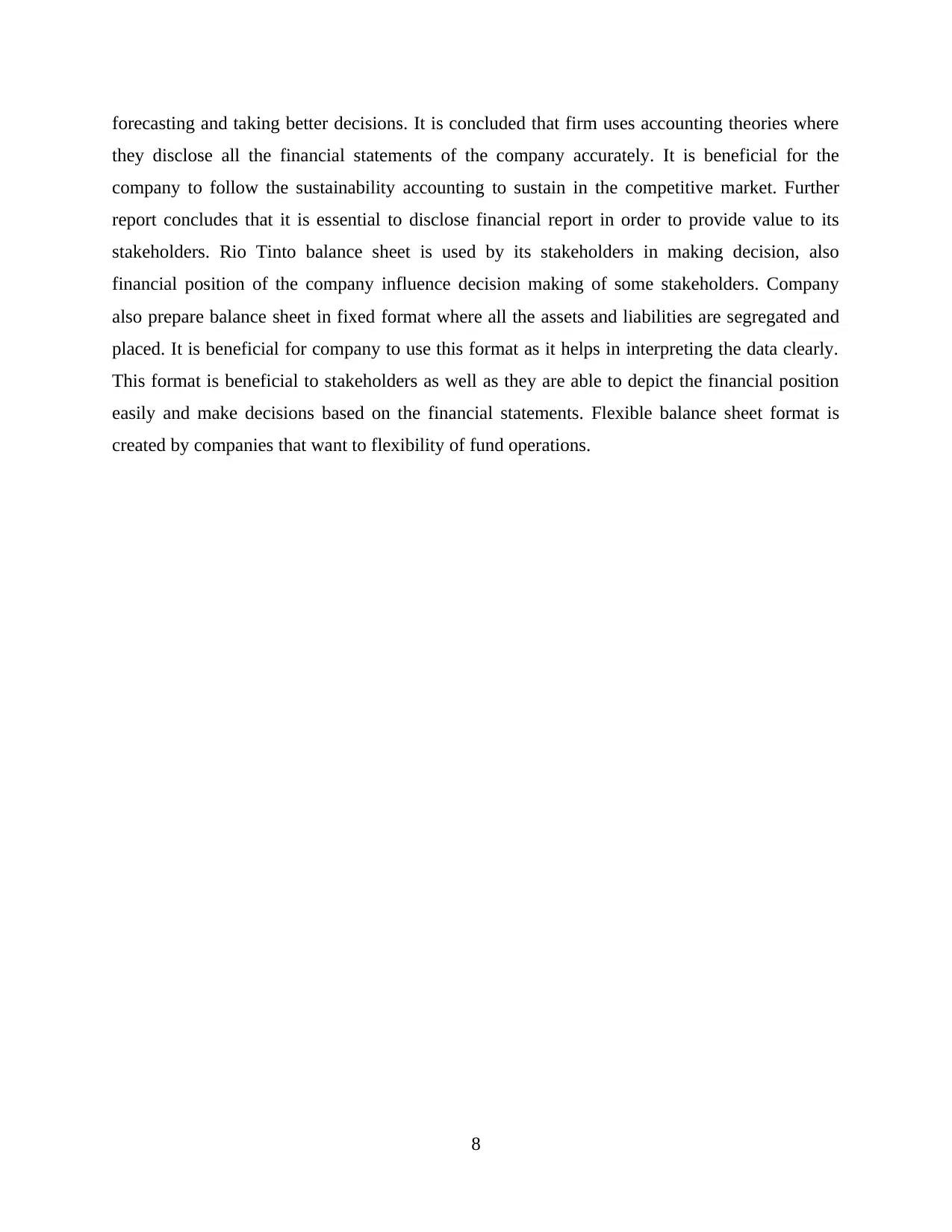
forecasting and taking better decisions. It is concluded that firm uses accounting theories where
they disclose all the financial statements of the company accurately. It is beneficial for the
company to follow the sustainability accounting to sustain in the competitive market. Further
report concludes that it is essential to disclose financial report in order to provide value to its
stakeholders. Rio Tinto balance sheet is used by its stakeholders in making decision, also
financial position of the company influence decision making of some stakeholders. Company
also prepare balance sheet in fixed format where all the assets and liabilities are segregated and
placed. It is beneficial for company to use this format as it helps in interpreting the data clearly.
This format is beneficial to stakeholders as well as they are able to depict the financial position
easily and make decisions based on the financial statements. Flexible balance sheet format is
created by companies that want to flexibility of fund operations.
8
they disclose all the financial statements of the company accurately. It is beneficial for the
company to follow the sustainability accounting to sustain in the competitive market. Further
report concludes that it is essential to disclose financial report in order to provide value to its
stakeholders. Rio Tinto balance sheet is used by its stakeholders in making decision, also
financial position of the company influence decision making of some stakeholders. Company
also prepare balance sheet in fixed format where all the assets and liabilities are segregated and
placed. It is beneficial for company to use this format as it helps in interpreting the data clearly.
This format is beneficial to stakeholders as well as they are able to depict the financial position
easily and make decisions based on the financial statements. Flexible balance sheet format is
created by companies that want to flexibility of fund operations.
8
Secure Best Marks with AI Grader
Need help grading? Try our AI Grader for instant feedback on your assignments.
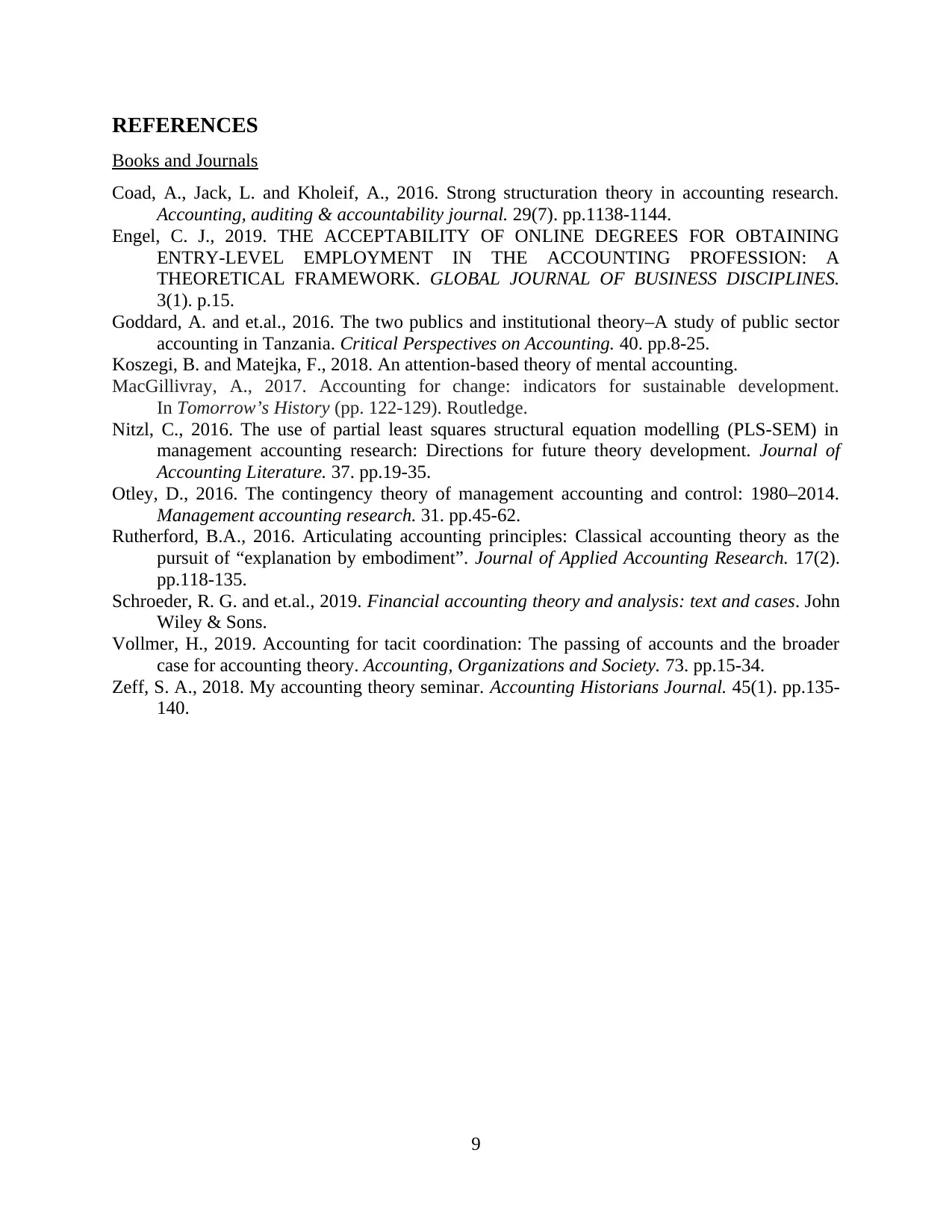
REFERENCES
Books and Journals
Coad, A., Jack, L. and Kholeif, A., 2016. Strong structuration theory in accounting research.
Accounting, auditing & accountability journal. 29(7). pp.1138-1144.
Engel, C. J., 2019. THE ACCEPTABILITY OF ONLINE DEGREES FOR OBTAINING
ENTRY-LEVEL EMPLOYMENT IN THE ACCOUNTING PROFESSION: A
THEORETICAL FRAMEWORK. GLOBAL JOURNAL OF BUSINESS DISCIPLINES.
3(1). p.15.
Goddard, A. and et.al., 2016. The two publics and institutional theory–A study of public sector
accounting in Tanzania. Critical Perspectives on Accounting. 40. pp.8-25.
Koszegi, B. and Matejka, F., 2018. An attention-based theory of mental accounting.
MacGillivray, A., 2017. Accounting for change: indicators for sustainable development.
In Tomorrow’s History (pp. 122-129). Routledge.
Nitzl, C., 2016. The use of partial least squares structural equation modelling (PLS-SEM) in
management accounting research: Directions for future theory development. Journal of
Accounting Literature. 37. pp.19-35.
Otley, D., 2016. The contingency theory of management accounting and control: 1980–2014.
Management accounting research. 31. pp.45-62.
Rutherford, B.A., 2016. Articulating accounting principles: Classical accounting theory as the
pursuit of “explanation by embodiment”. Journal of Applied Accounting Research. 17(2).
pp.118-135.
Schroeder, R. G. and et.al., 2019. Financial accounting theory and analysis: text and cases. John
Wiley & Sons.
Vollmer, H., 2019. Accounting for tacit coordination: The passing of accounts and the broader
case for accounting theory. Accounting, Organizations and Society. 73. pp.15-34.
Zeff, S. A., 2018. My accounting theory seminar. Accounting Historians Journal. 45(1). pp.135-
140.
9
Books and Journals
Coad, A., Jack, L. and Kholeif, A., 2016. Strong structuration theory in accounting research.
Accounting, auditing & accountability journal. 29(7). pp.1138-1144.
Engel, C. J., 2019. THE ACCEPTABILITY OF ONLINE DEGREES FOR OBTAINING
ENTRY-LEVEL EMPLOYMENT IN THE ACCOUNTING PROFESSION: A
THEORETICAL FRAMEWORK. GLOBAL JOURNAL OF BUSINESS DISCIPLINES.
3(1). p.15.
Goddard, A. and et.al., 2016. The two publics and institutional theory–A study of public sector
accounting in Tanzania. Critical Perspectives on Accounting. 40. pp.8-25.
Koszegi, B. and Matejka, F., 2018. An attention-based theory of mental accounting.
MacGillivray, A., 2017. Accounting for change: indicators for sustainable development.
In Tomorrow’s History (pp. 122-129). Routledge.
Nitzl, C., 2016. The use of partial least squares structural equation modelling (PLS-SEM) in
management accounting research: Directions for future theory development. Journal of
Accounting Literature. 37. pp.19-35.
Otley, D., 2016. The contingency theory of management accounting and control: 1980–2014.
Management accounting research. 31. pp.45-62.
Rutherford, B.A., 2016. Articulating accounting principles: Classical accounting theory as the
pursuit of “explanation by embodiment”. Journal of Applied Accounting Research. 17(2).
pp.118-135.
Schroeder, R. G. and et.al., 2019. Financial accounting theory and analysis: text and cases. John
Wiley & Sons.
Vollmer, H., 2019. Accounting for tacit coordination: The passing of accounts and the broader
case for accounting theory. Accounting, Organizations and Society. 73. pp.15-34.
Zeff, S. A., 2018. My accounting theory seminar. Accounting Historians Journal. 45(1). pp.135-
140.
9
1 out of 11
Your All-in-One AI-Powered Toolkit for Academic Success.
+13062052269
info@desklib.com
Available 24*7 on WhatsApp / Email
![[object Object]](/_next/static/media/star-bottom.7253800d.svg)
Unlock your academic potential
© 2024 | Zucol Services PVT LTD | All rights reserved.





